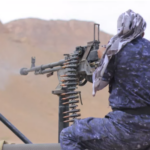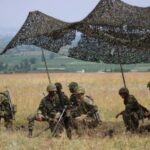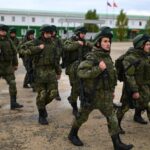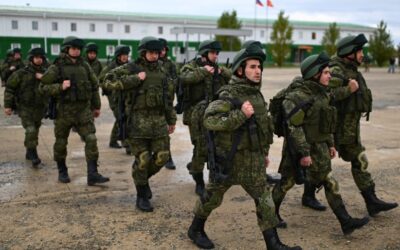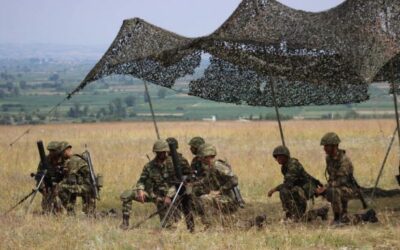Russia is recruiting hundreds of Yemeni Houthis for the war against Ukraine. The men were brought to Russia through a…

Nine states are strengthening their nuclear arsenals amid the armed conflict in Ukraine and the wider deterioration of the global security situation, the Swedish think tank Stockholm International Peace Research Institute (SIPRI) points out.
The global stockpile of nuclear warheads fell by nearly 200 to about 12,512 from early 2022 to early 2023, SIPRI notes in its annual report. Yet the number of nuclear weapons classified as operational, that is, ready to be used, increased by 86, and is now estimated to reach 9,576.
Not only do global reductions in operational nuclear warheads appear to have frozen, but their numbers are rising again, the institute’s researchers warn. At the same time, both the US and Russia have embarked on extensive and expensive programs to replace and modernize their nuclear warheads, missiles, aircraft, and submarines capable of launching them as well as their nuclear weapons production facilities.
Also read: SIPRI | Military spending in Europe peaks since the Cold War
For decades, the number of nuclear weapons has been steadily declining. However, the decrease was due mainly to the destruction of decommissioned nuclear warheads by Russia and the US. Researchers emphasize operational arsenals. As SIPRI reminds, in addition to Russia and the USA, China, France, Britain, Pakistan, India, Israel, and North Korea have such capabilities.
Most nuclear-weapon states are hardening their rhetoric about the importance of nuclear weapons and some have gone so far as to directly or indirectly threaten their potential use, notes Matt Korda, one of the report’s authors. Even worse, the diplomatic efforts to reduce nuclear arsenals have suffered heavy blows.
Russian President Vladimir Putin suspended New START – the only major US nuclear arms control agreement remaining in force – in February 2023.
In addition, negotiations to restore the international agreement on Iran’s nuclear energy program, officially the Joint Comprehensive Plan of Action (JCPOA), have been sidelined and overshadowed by Tehran’s support for Moscow and the political situation in the Islamic Democracy. A successful outcome of the effort to bring the parties back into full compliance appears unlikely, SIPRI finds.
Also read: Russia | Duma votes to suspend Russia’s participation in New START treaty
Russia and the US are by far the states with the largest arsenals: together, they possess about 90% of nuclear warheads. China has long occupied third place.
Most of the increase in operational heads is due to China, which from 350 arrived at 410. Beijing is investing heavily in its military to the degree that the Chinese economy and Chinese influence expand, according to SIPRI director Dan Smith.
India, Pakistan, and North Korea also increased their arsenals, like Russia, to a lesser extent (from 4,477 to 4,489 warheads), while the other powers with nuclear arsenals kept them as they were.
However, Mr. Smith notes that the world’s nuclear arsenal is still well below the 1980s, when it was surpassing 70,000 warheads.
For him, the increase in stocks cannot be explained simply by the war in Ukraine, taking into account factors such as the time required for their development and the fact that most countries that made this choice are not directly affected by the armed conflict.
Also read: SIPRI | Increase in arms imports to Europe – US dominance of global arms trade
READ MORE
Sweden | Funding for the production of Ukrainian long-range drones
Sweden has agreed to finance the production of Ukrainian long-range unmanned aerial vehicles, Ukraine’s Defence Ministry announced…
Russia | Debt cancellation for recruits who agree to fight in Ukraine
Russian President Vladimir Putin has signed a bill that will erase the debts of recruits joining the army to fight in Ukraine, according…
NATO | Emergency Cyber Security Conference in London
With the risk of multiple hybrid attacks on critical sectors for Britain’s infrastructure, as well as on large businesses by Russian hackers…
Russia | Recruiting hundreds of Yemeni Houthis in war against Ukraine
Russia is recruiting hundreds of Yemeni Houthis for the war against Ukraine. The men were brought to Russia through a…
Sweden | Funding for the production of Ukrainian long-range drones
Sweden has agreed to finance the production of Ukrainian long-range unmanned aerial vehicles, Ukraine’s Defence Ministry announced…
HCDI | Elite recruits in innovation roles in the Hellenic Armed Forces
A new program for the utilisation of scientifically qualified Greek citizens who are called to fulfil their military service is being…
Russia | Debt cancellation for recruits who agree to fight in Ukraine
Russian President Vladimir Putin has signed a bill that will erase the debts of recruits joining the army to fight in Ukraine, according…
PwC Cyprus, Multimarine, SignalGeneriX, and Theophrastus Join Forces for the EDA’s Symbiosis Project
A leading Consortium comprising PwC Cyprus, Multimarine Services Ltd, SignalGeneriX Ltd, and Theophrastus Research Institute, has been…









